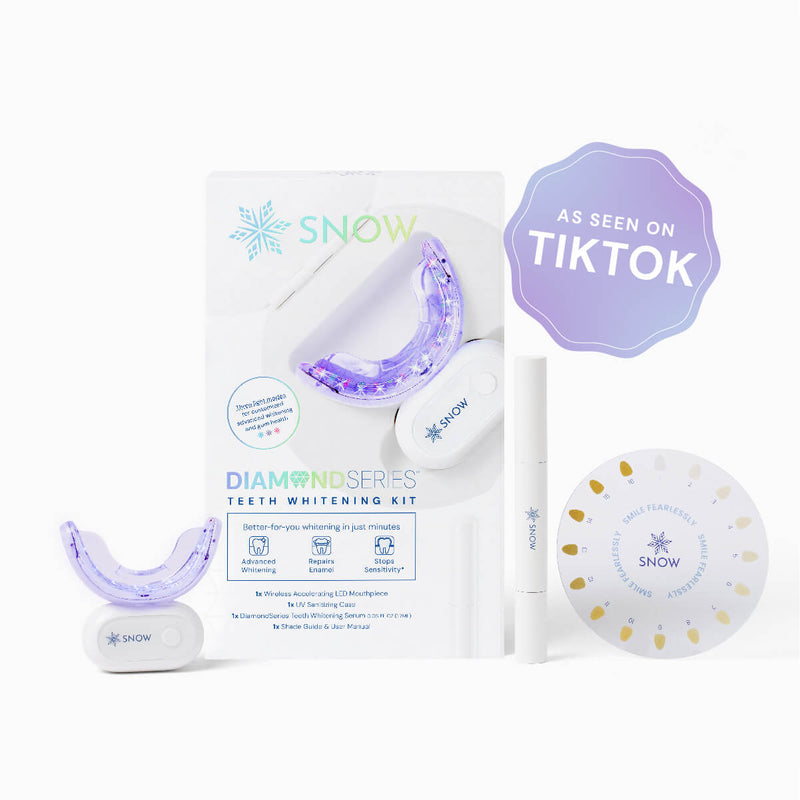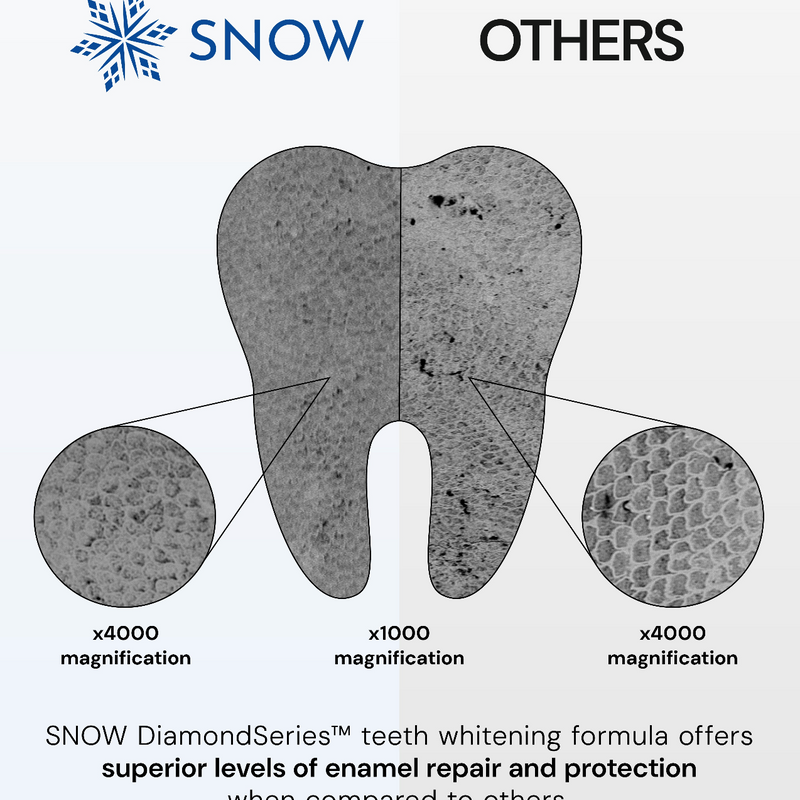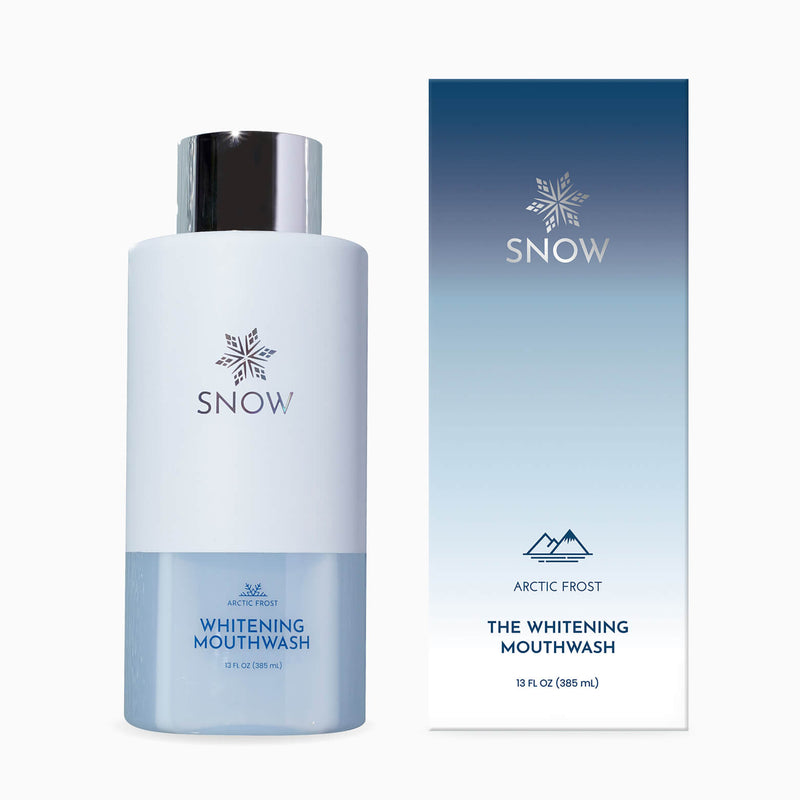Electric toothbrushes have revolutionized oral hygiene, offering advanced cleaning technology for healthier teeth and gums.
However, many users encounter a common issue: the electric toothbrush stops spinning when brushing too hard. This safety feature, designed to protect your teeth and gums from excessive pressure, can be confusing for some.
At SNOW, we draw on our extensive dental care expertise to help you understand and address this issue. In this comprehensive guide, we'll explore the mechanics of electric toothbrushes, discuss common problems affecting brush rotation, and provide step-by-step solutions.
We'll also share valuable tips on maintaining your toothbrush and answer frequently asked questions, ensuring you achieve optimal dental health with your electric toothbrush. Understanding the importance of toothbrush selection and maintenance is crucial for optimal oral health.
What this article covers:- How Electric Toothbrushes Work
- What Causes Your Brush Attachment to Rotate Improperly?
- What Are Some Common Electric Toothbrush Issues?
- How to Fix Electric Toothbrush Issues
- How to Protect Your Electric Toothbrush
- Toothbrush Stops Spinning FAQs
How Electric Toothbrushes Work
Electric toothbrushes work by using a motor to create rapid, automatic oscillations or rotations of the brush head. This motion is highly effective at removing plaque and debris from your teeth, significantly more so than manual brushing.
According to WebMD, the high-speed movements of electric toothbrushes can result in better plaque removal and healthier gums compared to manual toothbrushes. Many electric toothbrush models also include a pressure sensor.
This sensor alerts you when you're brushing too hard, and it can cause the brush to stop spinning to protect your teeth and gums from damage.
At SNOW, our LED Teeth Whitening Electric Toothbrush is designed with advanced features to enhance your dental care routine, including an effective pressure sensor and powerful cleaning action.
Additionally, using our Teeth Whitening Toothpaste in conjunction with your electric toothbrush can help achieve a brighter, healthier smile.

What Causes Your Brush Attachment to Rotate Improperly?
If your electric toothbrush head stops spinning, it could be due to several reasons. Understanding these can help you troubleshoot and fix the issue effectively.
Pressure Sensor Activation
Electric toothbrushes are designed with a pressure sensor that stops the motor when you brush too hard to protect your teeth and gums.
However, if the brush head stops spinning even with light pressure, it may indicate a defect in the sensor system itself.
Battery Issues
A common reason for the brush head to stop spinning is battery issues. If the battery is low or defective, it won't provide sufficient power to rotate the brush head.
According to WebMD, keeping your toothbrush fully charged ensures optimal performance and prevents power-related issues.
Motor Malfunctions
Internal motor malfunctions can also cause the brush head to stop spinning. The motor might be defective, or internal components may be misaligned.
This often requires professional repair or replacement of the toothbrush.
Mechanical Blockages
Debris or toothpaste buildup inside the brush mechanism can block the movement of the brush head. Regular cleaning of your toothbrush can prevent such blockages and ensure smooth operation.

What Are Some Common Electric Toothbrush Issues?
Electric toothbrushes are designed to stop spinning if you apply excessive pressure, which isn't necessarily a defect but a safety feature.
However, there are other instances where the brush stops spinning due to mechanical or technical issues. Here are some common problems you might encounter:
Brush Attachment Doesn't Click Into Place
If the brush head isn't securely attached, it won't spin correctly. This issue often arises if the brush head is not aligned properly with the handle. Make sure it clicks into place securely.
Drawing upon our research, we've found that ensuring a proper fit can resolve many spinning issues.
Toothbrush Makes Strange Sounds
Unusual noises from your electric toothbrush can indicate mechanical issues or obstructions inside the device.
These sounds might be caused by loose parts, debris, or internal damage. Regular maintenance and cleaning can prevent these issues.
If noises persist, it might be necessary to check for internal blockages or mechanical failures.
Toothbrush Charging Issues
If your toothbrush isn't charging properly, it won't have enough power to function. Ensure the charging base and connections are working correctly. A common cause of charging problems is a defective charging unit or a faulty battery.
We recommend checking the charger and battery health to help diagnose and resolve these issues.

How to Fix Electric Toothbrush Issues
Experiencing issues with your electric toothbrush can be frustrating, especially when it stops spinning unexpectedly.
While built-in pressure sensors are designed to halt the brush to protect your teeth, other problems might indicate defects.
Here's a step-by-step guide to troubleshoot and fix common electric toothbrush issues.
Step 1: Check Your Power Outlet
First, ensure that your power outlet is functioning correctly. Plug another device into the same outlet to verify it has power. Sometimes, the issue isn't with your toothbrush but with the power source itself. A working outlet is crucial for charging your toothbrush and ensuring its proper functionality.
Step 2: Check If Your Toothbrush Is Charged
A low or dead battery can cause your toothbrush to stop spinning. Make sure your toothbrush is fully charged.
A fully charged battery is essential for optimal performance. Place your toothbrush on the charger until it reaches full power. If it still doesn't work, the battery might be defective and need replacement.
Step 3: Check If Your Toothbrush Charger Is Working
Verify that your charger is working correctly. Try using a different charger or plugging the charger into a different outlet.
If the charger isn't functioning, it won't charge your toothbrush, causing it to stop spinning.
We've found that charging issues are a common problem that can often be resolved by replacing a faulty charger.
Step 4: Clean The Space Between The Power Button
Dirt or debris can interfere with the power button, preventing your toothbrush from operating correctly. Use a soft cloth to clean the area around the power button. This simple maintenance step can resolve many operational issues caused by accumulated grime.
Step 5: Check The Head Of The Toothbrush
Ensure the brush head is free of blockages and securely attached to the handle. If the brush head isn't properly attached or if there's debris obstructing its movement, it won't spin. Regularly clean and inspect the brush head to maintain its performance.
For more advanced and effective dental care, consider using SNOW's LED Teeth Whitening Electric Toothbrush and pairing it with our Teeth Whitening Toothpaste. These products are designed to enhance your brushing experience and ensure a brighter, healthier smile.
When considering electric toothbrush features, look for options that suit your specific oral care needs.
How to Protect Your Electric Toothbrush
Maintaining your electric toothbrush properly can extend its lifespan and ensure it functions effectively. Here are essential tips to protect your toothbrush:
Clean It Regularly To Remove Toothpaste Buildup
Regular cleaning is crucial to prevent toothpaste and debris buildup, which can interfere with the brush's operation.
According to WikiHow, you should rinse the brush head thoroughly after each use and occasionally soak it in a solution of water and vinegar to remove any stubborn deposits.
Store It Upright In A Clean, Dry Place To Prevent Moisture Buildup
Proper storage is vital to keep your toothbrush hygienic and prevent mold or bacteria growth. Store your electric toothbrush upright in a holder that allows it to air dry completely between uses.
This practice helps prevent moisture buildup, which can damage the internal components of the toothbrush.
Learning how to organize toothbrushes effectively can help maintain cleanliness and extend the life of your brushes.
Replace The Brush Head Every Three Months
Replacing the brush head every three months is essential for maintaining optimal cleaning performance and oral health. Over time, brush bristles can become frayed and less effective at cleaning your teeth.
Regularly changing the brush head ensures that your toothbrush continues to remove plaque effectively.
When it comes to electric toothbrushes, knowing how to pick a toothbrush with replaceable brush heads is crucial for optimal oral health.

Toothbrush Stops Spinning FAQs
Is it normal for an electric toothbrush to stop spinning?
Yes, it's often due to the pressure sensor activating when you brush too hard, but if it stops spinning as soon as it makes contact with your teeth, it may need troubleshooting or outright replacement.
What should I do if troubleshooting doesn't work?
If basic troubleshooting doesn't resolve the issue, consider consulting the manufacturer's guidelines or contacting customer support for further assistance.
If you can't get it working again, it's probably time to get a replacement toothbrush. The good news is that, with high-quality electric toothbrushes like ours, replacing your toothbrush shouldn't be a concern for several years.
For those wondering about using an electric toothbrush after wisdom teeth removal, it's best to consult your dentist for personalized advice.
Conclusion
Electric toothbrushes are an excellent tool for maintaining dental health, but they require proper care and troubleshooting when issues arise.
If your electric toothbrush head stops spinning, and it's not as a result of excessive force or pressure on your part, follow these steps to diagnose and fix the problem. For more advanced issues, consider reaching out to the manufacturer or a professional repair service.
For more information on maintaining your oral health, check out SNOW's LED Teeth Whitening Electric Toothbrush here, or check out any of our teeth whitening products.
Did you know that the most popular toothbrush color is blue? Our LED Whitening Electric Toothbrush comes in this classic shade!
If you want to learn more, why not check out our related posts:
- How Should You Hold the Toothbrush During Brushing
- How Much Toothpaste Should You Put on a Toothbrush
- How Long Do Electric Toothbrushes Last?
- How Long Does an Electric Toothbrush Take to Charge?
- Best Electric Toothbrush Heads
- How Long Should You Brush Your Teeth With an Electric Toothbrush?
- How Long Does Herpes Live on a Toothbrush?
- Are Electric Toothbrush Heads Interchangeable?
- How Long Does It Take for a Toothbrush to Dry?
- What Are Toothbrush Bristles Made of?
- How Many Bristles Are on a Toothbrush?
- Are Soft Toothbrushes Good?
- Electric Toothbrush Side Effects
- Why Do My Toothbrush Bristles Get Hard?
- Are Mouthpiece Toothbrushes Effective?
























